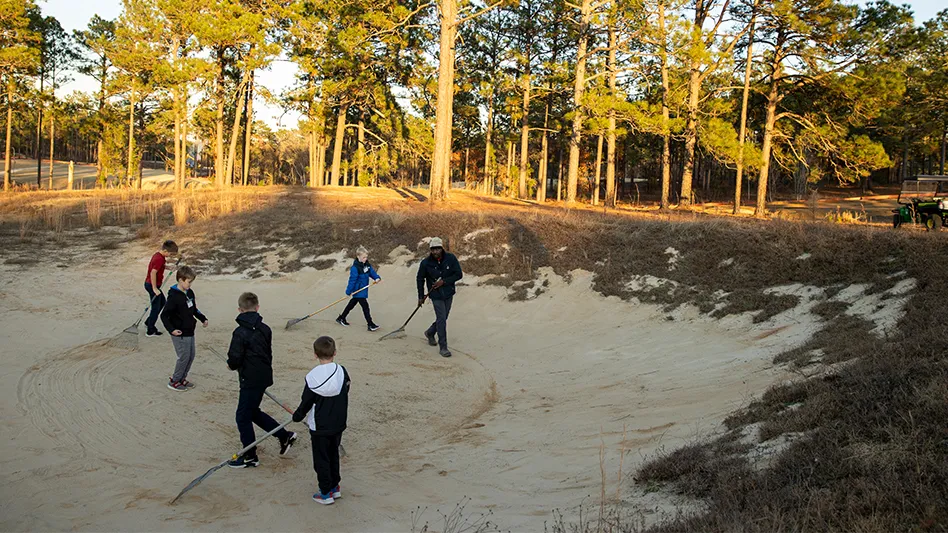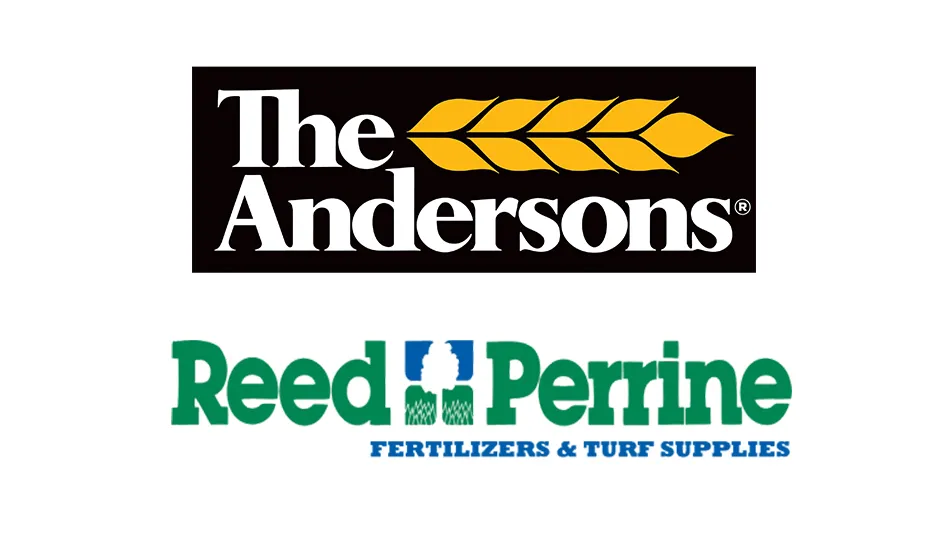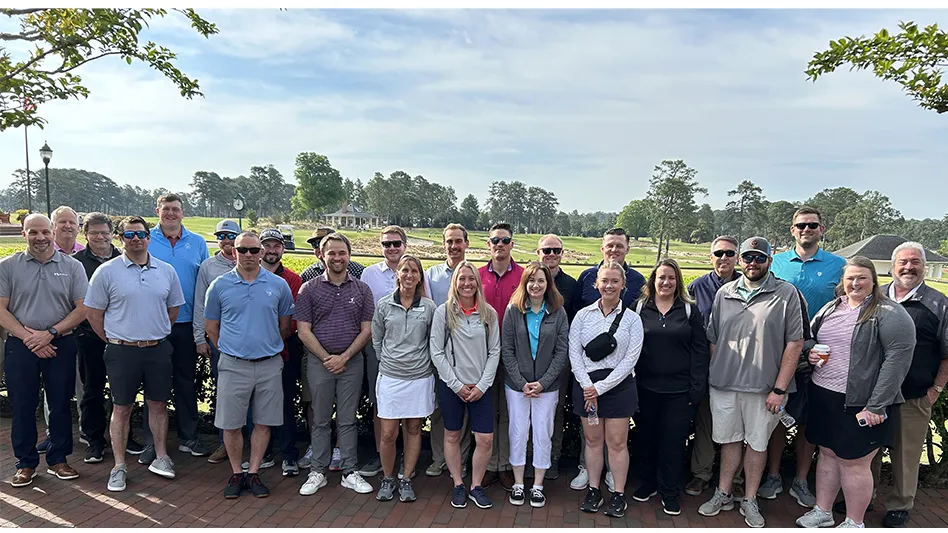
Even somebody who holds one of the industry’s most desirable jobs must report to members. But the members Paul Vermeulen works to satisfy can unleash nearly quarter-mile drives, go weeks without missing a 3-footer and understand the difference between a 95- and 97-yard wedge shot.
Vermeulen’s members are PGA Tour players. His job as the PGA Tour’s vice president of competitions agronomy requires regular dialogue with players who arrive at tournament sites seeking one course conditioning characteristic above others.
“They put a very high priority on playing the golf course firm,” Vermeulen says. “They don’t place a high priority on playing the golf course fast like so many people think. They are athletes and they are competitive, and they enjoy a challenge. When they play a firm golf course, that’s when they feel they are challenged.”
Providing firm conditions can be a challenge for any superintendent, especially one lacking PGA Tour resources, a point Vermeulen emphasized throughout his presentation during the Kentucky Turfgrass Council golf conference at the GIE+EXPO in Louisville. A 10-year PGA Tour employee and former USGA Green Section agronomist, Vermeulen works with superintendents and crews hosting PGA Tour, Champions Tour and Web.com Tour competitions.
The PGA Tour, Vermeulen says, defines agronomic success as meeting the playing demands of its membership. Vermeulen immediately shifts the attention to providing firmness – without losing sight of green speed and aesthetics – when visiting a tournament site.
Vermeulen revealed several factors in his KTC presentation that allow PGA Tour sites to achieve its goal of providing optimal firmness when tournaments conclude on Sundays.
Favorable schedule. A PGA Tour week consists of limited Monday activity, Tuesday practice rounds, a Wednesday pro-am, full-field starts on Thursday and Friday, and a trimmed field with stacked Saturday and Sunday tee times. The schedule provides opportunities for morning and afternoon maintenance each day, allowing superintendents and crews to effectively control the volume of water dispersed on the course. “While your Saturdays and Sundays are probably your two busiest days, our Saturdays and Sundays are our two lightest days,” Vermeulen tells superintendents. “Therein lies the fundamental difference.”
Resources to collect and measure. Dozens of volunteers at most tournaments turn greens into crowded morning and evening spots because of the personnel needed to collect usable data. The PGA Tour leans on three devices – soil moisture meters, stimpmeters and firmness meters – for data collection. The first two devices can be found in most maintenance buildings. Firmness meters are less common. Recording firmness involves dropping a golf ball-sized bearing from 6 feet and measuring the depth of the depression. The simple process isn’t bulletproof, and Vermeulen says numbers on new Bermudagrass surfaces can “get a little bit fuzzy.” But firmness meters are especially reliable on cool-season grasses and can provide confirmation when players provide feedback.
“When we watch the data coming in from that meter and have conversations with the players, we can correlate what we are getting on that meter with the response we are getting from our members,” Vermeulen says. “When they start telling us, the golf course is really starting to get bouncy, we measure it, we quantify it, and we can use that information to help the next tournament site establish a target in getting their course ready for competition.”
Trust. The pair of turf professionals responsible for hand watering front and back nine greens spend more time with Vermeulen than anybody else during advance and tournament week. “They have to be really, really, really precise,” he says. Vermeulen trains the pair to work backward to achieve desired moisture readings. This means the Sunday target drives irrigation decisions throughout the week. Vermeulen’s goal is to drop moisture readings ½ percent per each tournament day. Calibration is a key part of hand watering training. “The people we are training can tell you exactly how much water is coming out of the hose,” Vermeulen says.
A long-term strategy. Mowing and rolling can lead to manufactured green speeds. Firmness, though, can’t be altered on a whim. “Firmness takes patience and time,” Vermeulen says. “I have on many occasions tried to measure the impact of mowing and rolling on firmness. The idea would be, if you can roll the greens to get them firm and you need firmness, then you roll the green. Rollers don’t really have that immediate impact. They have an impact, but it’s cumulative over time. As the soil dries, it becomes agreeable to firming up and it firms up every time you put the roller out there.”
Guy Cipriano is GCI’s senior editor.
Vermeulen’s members are PGA Tour players. His job as the PGA Tour’s vice president of competitions agronomy requires regular dialogue with players who arrive at tournament sites seeking one course conditioning characteristic above others.
“They put a very high priority on playing the golf course firm,” Vermeulen says. “They don’t place a high priority on playing the golf course fast like so many people think. They are athletes and they are competitive, and they enjoy a challenge. When they play a firm golf course, that’s when they feel they are challenged.”
Providing firm conditions can be a challenge for any superintendent, especially one lacking PGA Tour resources, a point Vermeulen emphasized throughout his presentation during the Kentucky Turfgrass Council golf conference at the GIE+EXPO in Louisville. A 10-year PGA Tour employee and former USGA Green Section agronomist, Vermeulen works with superintendents and crews hosting PGA Tour, Champions Tour and Web.com Tour competitions.
The PGA Tour, Vermeulen says, defines agronomic success as meeting the playing demands of its membership. Vermeulen immediately shifts the attention to providing firmness – without losing sight of green speed and aesthetics – when visiting a tournament site.
Vermeulen revealed several factors in his KTC presentation that allow PGA Tour sites to achieve its goal of providing optimal firmness when tournaments conclude on Sundays.
Favorable schedule. A PGA Tour week consists of limited Monday activity, Tuesday practice rounds, a Wednesday pro-am, full-field starts on Thursday and Friday, and a trimmed field with stacked Saturday and Sunday tee times. The schedule provides opportunities for morning and afternoon maintenance each day, allowing superintendents and crews to effectively control the volume of water dispersed on the course. “While your Saturdays and Sundays are probably your two busiest days, our Saturdays and Sundays are our two lightest days,” Vermeulen tells superintendents. “Therein lies the fundamental difference.”
Resources to collect and measure. Dozens of volunteers at most tournaments turn greens into crowded morning and evening spots because of the personnel needed to collect usable data. The PGA Tour leans on three devices – soil moisture meters, stimpmeters and firmness meters – for data collection. The first two devices can be found in most maintenance buildings. Firmness meters are less common. Recording firmness involves dropping a golf ball-sized bearing from 6 feet and measuring the depth of the depression. The simple process isn’t bulletproof, and Vermeulen says numbers on new Bermudagrass surfaces can “get a little bit fuzzy.” But firmness meters are especially reliable on cool-season grasses and can provide confirmation when players provide feedback.
“When we watch the data coming in from that meter and have conversations with the players, we can correlate what we are getting on that meter with the response we are getting from our members,” Vermeulen says. “When they start telling us, the golf course is really starting to get bouncy, we measure it, we quantify it, and we can use that information to help the next tournament site establish a target in getting their course ready for competition.”
Trust. The pair of turf professionals responsible for hand watering front and back nine greens spend more time with Vermeulen than anybody else during advance and tournament week. “They have to be really, really, really precise,” he says. Vermeulen trains the pair to work backward to achieve desired moisture readings. This means the Sunday target drives irrigation decisions throughout the week. Vermeulen’s goal is to drop moisture readings ½ percent per each tournament day. Calibration is a key part of hand watering training. “The people we are training can tell you exactly how much water is coming out of the hose,” Vermeulen says.
A long-term strategy. Mowing and rolling can lead to manufactured green speeds. Firmness, though, can’t be altered on a whim. “Firmness takes patience and time,” Vermeulen says. “I have on many occasions tried to measure the impact of mowing and rolling on firmness. The idea would be, if you can roll the greens to get them firm and you need firmness, then you roll the green. Rollers don’t really have that immediate impact. They have an impact, but it’s cumulative over time. As the soil dries, it becomes agreeable to firming up and it firms up every time you put the roller out there.”
Guy Cipriano is GCI’s senior editor.
Latest from Golf Course Industry
- USGA opens Golf House Pinehurst
- Bernhard Academy expands leadership team
- Another record year for research
- The Highlands pays more homage to Ross
- Audubon International adds veteran superintendent to leadership team
- South Florida simmer
- Devising safer landings
- SiteOne adds Durentis to product offerings





